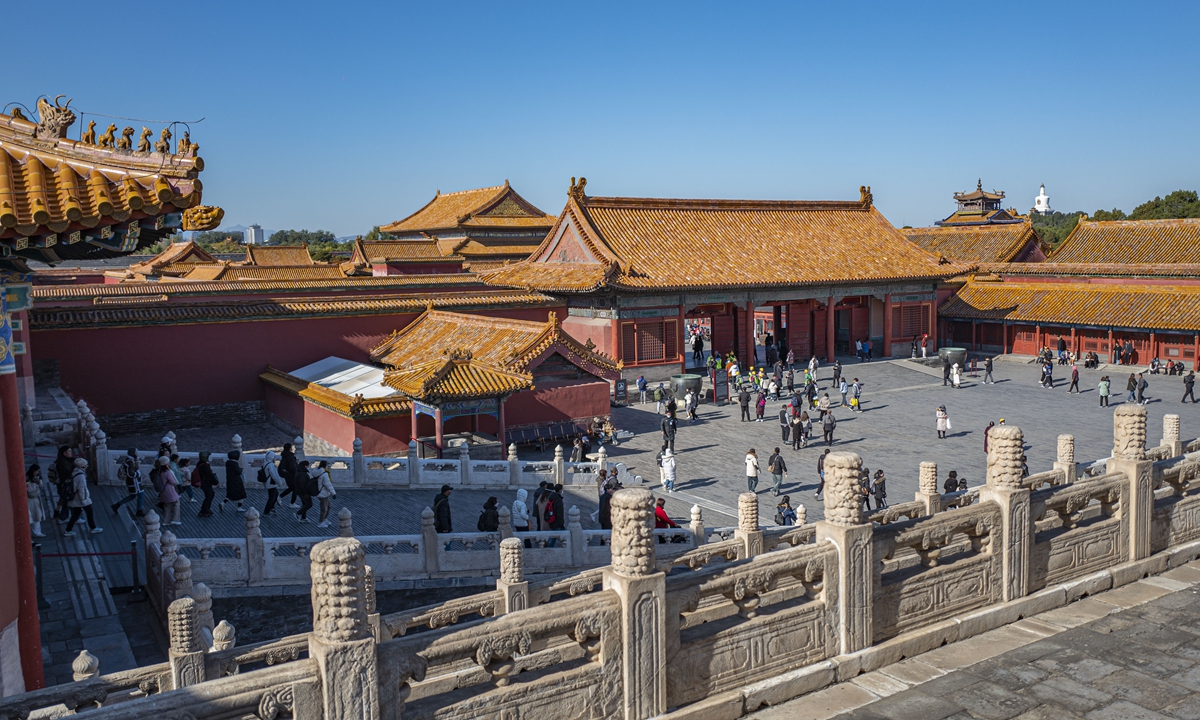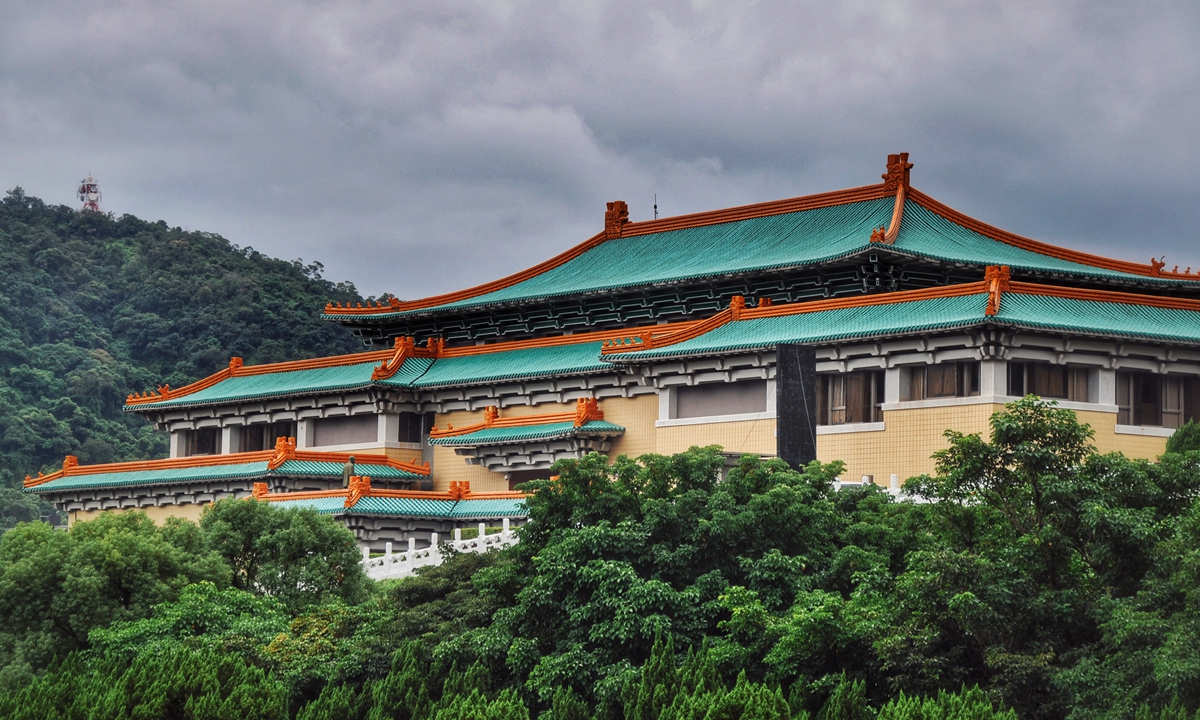
Tourists enjoy themselves at the Palace Museum in Beijing. Photo: VCG
The Chinese civilization is the key to keeping people across the Taiwan Straits connected despite certain secessionists political bodies are trying to deny it, Chinese scholars and analysts have stated.
The secessionist forces on the island of Taiwan, led by the Democratic Progressive Party (DPP) authorities, have continued to pursue an acrimonious path in the development of cross-Straits ties and provocation of the Chinese mainland. This has resulted in the stunting of many aspects of the cross-Straits cooperation and dialogue.
Ji Bin, a senior official with the All-China Federation of Taiwan Compatriots, said that despite the DPP authorities' attempts to undermine the importance of traditional culture on the island, Chinese culture is still the foundation that connects compatriots on both sides of the Taiwan Straits.
"The national reunification we are pursuing is not only a reunification on paper, but more importantly, a spiritual unity of compatriots on both sides of the Taiwan Straits," Ji said at the 9th Forum on Chinese Culture, an annual event hosted by Peking University where over 150 scholars and experts from both sides of the Taiwan Straits gathered.
He also emphasized that the inclusivity of Chinese civilization is the linchpin to achieving a high-quality form of reunification.
"The achievement of this goal cannot be separated from transforming Chinese culture into a spiritual bond for cultural exchanges, and placing Chinese cultural identity at the spiritual core to construct a cross-Straits community of shared destiny," Ji said. Several high-profile cultural exhibitions, led by a 2011 showing of Dwelling in the Fuchun Mountains, a masterpiece by Yuan Dynasty (1279-1368) artist Huang Gongwang, at the Palace Museum in Taipei, have been tremendously popular.

The Palace Museum in Taipei Photo: VCG
The piece, burnt into two pieces in 1650 during the Qing Dynasty (1644-1911) was separated during the civil war in the mid-20th century, with one part remaining on the Chinese mainland, which underlines the shared cultural heritage between the two sides of the Taiwan Straits, said Feng Ming-chu, former chief of the Palace Museum in Taipei.
"We are all the inheritors of Chinese culture, which is so profound that it is worth our efforts to promote, as it is shared by the two sides of the Taiwan Straits," Feng told the Global Times.
She also noted that the continued inheritance of Chinese culture by both the island of Taiwan and the Chinese mainland underscores an intrinsic connection between the two sides.
"Nobody could erase the fact that we are sharing the same culture," Feng noted.
Wang Zaixi, vice president of the National Society of Taiwan Studies, highlighted the pivotal role that cultural integration has played in the perpetual rise and fall of the Chinese nation over five millennia.
"One of the major reasons why the Chinese nation has been divided and reunited over the last 5,000 years and has always maintained a great unity is the strong cohesion, and centripetal and inspirational power of Chinese culture," Wang said.
Speaking the same language
Yok Mu-ming, former chairman of the New Party in Taiwan, said that the enduring nature of Chinese culture is a testament to the profound value placed by the Chinese people on family.
"The resilience of the Chinese nation lies in its ability to coalesce in the face of external challenges, reinforcing its unity and strength," he told reporters.
Ho Hui-li, an expert on culture from Taiwan at Tianjin University, brought attention to the practical cultural symbols that could bridge the gap between the two sides.
She advocated for the effective utilization of cultural icons such as Mazu within the island of Taiwan.
Mazu culture, which also holds influence in the southeastern coastal regions of the Chinese mainland, promotes a spirit of volunteerism and selfless dedication, according to Ho.
"For people who don't know much about Mazu, excluding the religious perspective, we can interpret her role as a role model for volunteering, which is equally understandable for both sides of the Taiwan Straits," Ho told the Global Times.
Ho believes that this cultural commonality could serve as a foundation for communication and collaboration between the two sides, noting that "we can work on whether people in Taiwan could volunteer to participate in the mainland rural revitalization activities, an act that would add personal value to their held beliefs as an expression of pure goodwill to each other."
Embracing the future
Chang Ching, a senior research fellow with the Society for Strategic Studies in Taiwan, called for the integration of cutting-edge technologies in promoting Chinese culture among the young generation.
"It could be used as a tool to strengthen Chinese education. We can't reject an information society, nor can we reject AI, which has already entered our lives," Chang said.
"If we can master it and turn it into a tool for cultural innovation and inheritance, I think the future is boundless."
The prevailing sentiment at the forum was that cultural understanding and collaboration hold the key to fostering unity and preventing conflicts.
Chi Chun-Chen, a professor with Ming Chuan University in Taiwan, stressed the importance of continuing to strengthen communication among the youth to reduce misunderstandings, break down stereotypes, and foster genuine connections.
He argued that fostering youth exchanges has become even more critical at a time when secessionists are intensifying their separatist campaigns.
"Youth exchanges must be strengthened as it is a prolific way to strengthen communication and reduce misunderstandings," Chi said, emphasizing that "it's even more important when there are people blatantly advocating for Taiwan secessionism."
"The journey toward peaceful reunification may be long and challenging, but through cultural integration and understanding, the people on both sides can strive toward a harmonious and united future," Chi said.
URL: https://www.seeglobalnews.com/read-2638.html